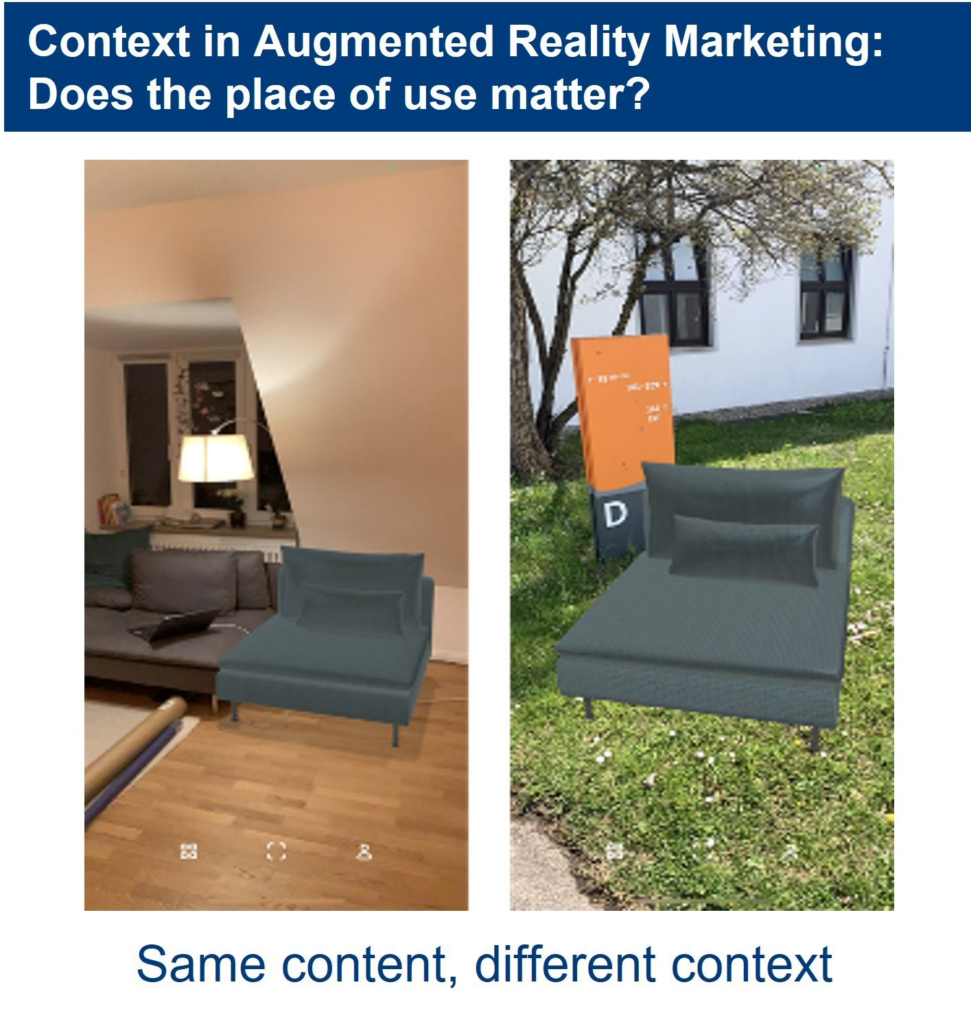Augmented Reality (AR) is already widely used in today’s marketing world. AR allows customers to integrate virtual content into their perception of the real world. Product visualisations are now almost standard – and more use cases are emerging. This makes it all the more important to address the topic of AR marketing – as a company and as a researcher.
Augmented Reality and Context
A crucial point that has been neglected in previous AR research is the physical context in which AR content is consumed. The word “context” comes from Latin and is made up of the words “con-” and “textus”. “Con- means ‘together’ or ‘with’, while textus can be translated as ‘fabric’ or ‘web’. There are of course various contextual factors in AR (e.g. smell, volume, dirt, etc.) – and of course the place of use as the “physical context”.
This is the question we have addressed. Is the same content valued differently in different places? Is the washing machine in the photo on the beach (“inappropriate context”) rated better or worse than in the customer’s laundry room (“appropriate context”)? Intuitively, I would say yes. But it’s not quite that simple.

Study: How the context of use affects the AR experience
The aim of the study “Context in Augmented Reality Marketing: Does the place of use matter?” (download) was to find out how people evaluate identical AR content (e.g. a virtual sofa) in different locations (e.g. at home versus in a lecture hall). We investigated this in two studies that have now been published in the journal Psychology and Marketing. This journal has an acceptance rate of 19%, meaning that less than one in five manuscripts submitted is actually published. [Journal Citation Indicator (Clarivate): 1.1; Journal Impact Factor (Clarivate): 5.507]
The first study was conducted on the campus of the University of the Bundeswehr in Munich. Students were interviewed either on campus or in their dorm rooms (i.e. different contexts). They were asked to look at a sofa in the Ikea Place app. In the second study, we interviewed consumers at home through a professional market research company. They tested and rated a kettle in the kitchen and in the living room using the SAGE app. By uploading screenshots, we were able to ensure that the apps were being used correctly.
Study: Why appropriate context in AR is good and why not.
The results show that context does have an impact on the evaluation and rating of AR content – but not quite as simple as one might expect.
- An appropriate context leads consumers to rate the experience as plausible. Plausible experiences are good because they are perceived as more useful.
- However, a suitable context leads (paradoxically) to a lower “local presence”, i.e. the perception that the virtual product is “really here”. So, in colloquial terms, the virtual object is perceived as “less real” – which is not good. This could be due to the fact that the virtual objects are in direct comparison with a typical context and other “real” products (e.g. other furniture) – and current technologies are simply not yet competitive here.
- The following figure shows the model with the results of the first study.

Context Matters!
Context has been largely neglected in AR research. With this study, we show that the place of use must play a very special role. AR is not always useful, and especially not everywhere – a realisation that should be kept in mind when discussing the metaverse. The task now is to compensate for the negative effects – the reduced local presence in the “right” place. This can be done primarily through better design, better tracking and better devices. Context-adaptive forms of presentation could also adapt AR content to the design of the environment.

Download: Research on Context in Augmented Reality Marketing
You can download the research paper for free (open access)
Von der Au, Simon; Rauschnabel, Philipp A.; Felix, Reto; Hinsch, Chris (2023). Context in augmented reality marketing: Does the place of use matter?, Psychology & Marketing, in Veröffentlichung; DOI: https://doi.org/10.1002/mar.21814
Further Literature
Rauschnabel, P. A., Felix, R., Hinsch, C., Shahab, H., & Alt, F. (2022). What is XR? Towards a framework for augmented and virtual reality. Computers in Human Behavior, 133, 107289.
Rauschnabel, P.A., Babin, B., Krey, N., & Jung, T. (2022). What is Augmented Reality Marketing? Its definition, complexity, and future. Journal of Business Research, 142, 1140-1150.